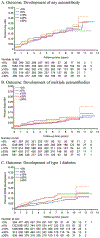Increasing plasma glucose before the development of type 1 diabetes-the TRIGR study
- PMID: 34369627
- PMCID: PMC8530903
- DOI: 10.1111/pedi.13251
Increasing plasma glucose before the development of type 1 diabetes-the TRIGR study
Abstract
Objective: The β-cell stress hypothesis suggests that increased insulin demand contributes to the development of type 1 diabetes. In the TRIGR trial we set out to assess the profile of plasma glucose and HbA1c before the diagnosis of clinical diabetes compared to nondiabetic children.
Research design and methods: A cohort of children (N = 2159) with an affected first-degree relative and increased HLA risk were recruited 2002-2007 and followed until 2017. To study the relationship between plasma glucose/HbA1c and the development of autoantibodies or clinical disease Kaplan-Meir curves were developed. Mixed models were constructed for plasma glucose and HbA1c separately.
Results: A family history of type 2 diabetes was related to an increase in plasma glucose (p < 0.001). An increase in glucose from the previous sample predicted clinical diabetes (p < 0.001) but not autoantibodies. An increase of HbA1c of 20% or 30% from the previous sample predicted the development of any autoantibody (p < 0.003 resp <0.001) and the development of diabetes (p < 0.002 resp <0.001. Participants without autoantibodies had lower HbA1c (mean 5.18%, STD 0.24; mean 33.08 mmol/mol, STD 2.85) than those who progressed to clinical disease (5.31%, 0.42; 34.46 mmol/mol, 4.68; p < 0.001) but higher than those who developed any autoantibody (5.10%, 0.30; 32.21 mmol/mol, 3.49; p < 0.001), or multiple autoantibodies (5.11%, 0.35; 32.26 mmol/mol, 3.92; p < 0.003).
Conclusions: A pronounced increase in plasma glucose and HbA1c precedes development of clinical diabetes, while the association between plasma glucose or HbA1c and development of autoantibodies is complex. Increased insulin demand may contribute to development of type 1 diabetes.
Keywords: HbA1c; accelerator hypothesis; autoantibodies; plasma glucose; type 1 diabetes; β-cell stress.
© 2021 The Authors. Pediatric Diabetes published by John Wiley & Sons Ltd.
Conflict of interest statement
Declaration of interests
The authors have no industry links and other personal connections that could influence this study, and have no conflicts of interest to disclose
Figures


References
-
- Hyöty H, Hiltunen M, Knip M, Laakkonen M, Vähäsalo P, Karjalainen J et al. A prospective study of the role of coxsackie B and other enterovirus infections in the pathogenesis of IDDM Childhood Diabetes in Finland (DiMe) Study Group. Diabetes. 1995;44:652–657. - PubMed
-
- Ludvigsson J, .Afoke AO Seasonality of type 1 (insulin-dependent) diabetes mellitus: values of C-peptide, insulin antibodies and haemoglobin A1c show evidence of a more rapid loss of insulin secretion in epidemic patients. Diabetologia 1989, 32:84–91. - PubMed
-
- Akerblom HK, Reunanen A. The epidemiology of insulin-dependent diabetes mellitus (IDDM) in Finland and in northern Europe. Diabetes Care. 1985. Sep-Oct 8, Suppl 1:10–6 - PubMed
Publication types
MeSH terms
Substances
Grants and funding
LinkOut - more resources
Full Text Sources
Medical
Research Materials

